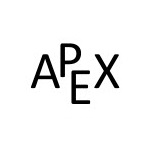Our study of limits led to continuous functions, which is a certain class of functions that behave in a particularly nice way. Limits then gave us an even nicer class of functions, functions that are differentiable.
This chapter explores many of the ways we can take advantage of the information that continuous and differentiable functions provide.
Given any quantity described by a function, we are often interested in the largest and/or smallest values that quantity attains. For instance, if a function describes the speed of an object, it seems reasonable to want to know the fastest/slowest the object traveled. If a function describes the value of a stock, we might want to know how the highest/lowest values the stock attained over the past year. We call such values extreme values.
Definition : Minima and Maxima
Let be defined on an interval containing .
- is the minimum (also, absolute minimum) of on if for all in .
- is the maximum} (also, absolute maximum) of on if for all in .
The maximum and minimum values are the extreme values, or extrema, of on .
The extreme values of a function are "'' values, values the function attains, not the input values.
Consider Figure . The function displayed in (a) has a maximum, but no minimum, as the interval over which the function is defined is open. In (b), the function has a minimum, but no maximum; there is a discontinuity in the "natural'' place for the maximum to occur. Finally, the function shown in (c) has both a maximum and a minimum; note that the function is continuous and the interval on which it is defined is closed.
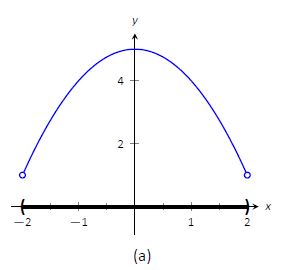
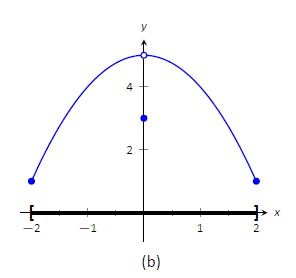
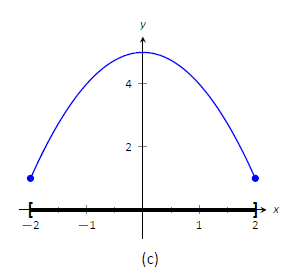
Figure : Graphs of functions with and without extreme values
It is possible for discontinuous functions defined on an open interval to have both a maximum and minimum value, but we have just seen examples where they did not. On the other hand, continuous functions on a closed interval always have a maximum and minimum value.
Theorem : The Extreme Value Theorem
Let be a continuous function defined on a closed interval . Then has both a maximum and minimum value on .
This theorem states that has extreme values, but it does not offer any advice about how/where to find these values. The process can seem to be fairly easy, as the next example illustrates. After the example, we will draw on lessons learned to form a more general and powerful method for finding extreme values.
Example : Approximating Extreme Values
Consider on , as graphed in Figure . Approximate the extreme values of .
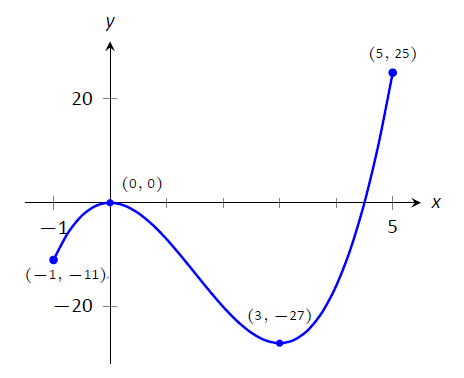
Figure : A graph of as in Example
Solution
The graph is drawn in such a way to draw attention to certain points. It certainly seems that the smallest value is , found when . It also seems that the largest value is 25, found at the endpoint of , . We use the word seems, for by the graph alone we cannot be sure the smallest value is not less than . Since the problem asks for an approximation, we approximate the extreme values to be and .
Notice how the minimum value came at "the bottom of a hill," and the maximum value came at an endpoint. Also note that while is not an extreme value, it would be if we narrowed our interval to . The idea that the point is the location of an extreme value for some interval is important, leading us to a definition.
Local and Relative Extrema
The terms local minimum and local maximum are often used as synonyms for relative minimum and relative maximum. We briefly practice using these definitions.
Definition : Relative Minimum and Relative Maximum
Let be defined on an interval containing .
- If there is an open interval containing such that is the minimum value, then is a relative minimum of . We also say that has a relative minimum at .
- If there is an open interval containing such that is the maximum value, then is a relative maximum of . We also say that has a relative maximum at .
The relative maximum and minimum values comprise the relative extrema of .
Example : Approximating Relative Extrema
Consider , as shown in Figure . Approximate the relative extrema of . At each of these points, evaluate .
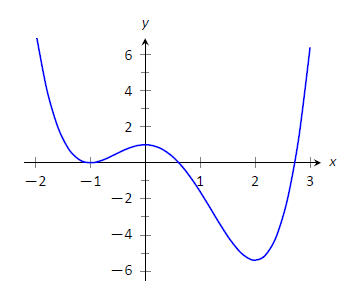
Figure : A graph of as in Example .
Solution
We still do not have the tools to exactly find the relative extrema, but the graph does allow us to make reasonable approximations. It seems has relative minima at and , with values of and . It also seems that has a relative maximum at the point .
We approximate the relative minima to be and ; we approximate the relative maximum to be .
It is straightforward to evaluate at and . In each case, .
Example : Approximating Relative Extrema
Approximate the relative extrema of , shown in Figure . At each of these points, evaluate .

Figure : A graph of as in Example .
Solution
The figure implies that does not have any relative maxima, but has a relative minimum at . In fact, the graph suggests that not only is this point a relative minimum, the minimum value of the function.
We compute . When , is undefined.
What can we learn from the previous two examples? We were able to visually approximate relative extrema, and at each such point, the derivative was either or it was not defined. This observation holds for all functions, leading to a definition and a theorem.
Definition : Critical Numbers and Critical Points
Let be defined at . The value is a critical number (or critical value) of if or is not defined.
If is a critical number of , then the point is a critical point of .
Theorem : Relative Extrema and Critical Points
Let a function have a relative extrema at the point . Then is a critical number of .
Be careful to understand that this theorem states "All relative extrema occur at critical points." It does not say "All critical numbers produce relative extrema." For instance, consider . Since , it is straightforward to determine that is a critical number of . However, has no relative extrema, as illustrated in Figure .
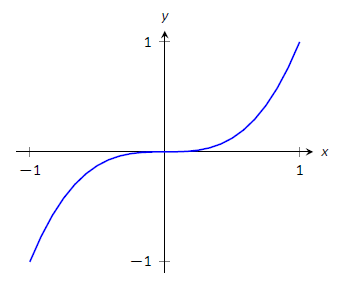
Figure : A graph of which has a critical value of , but no relative extrema.
Theorem states that a continuous function on a closed interval will have absolute extrema, that is, both an absolute maximum and an absolute minimum. These extrema occur either at the endpoints or at critical values in the interval. We combine these concepts to offer a strategy for finding extrema.
Key Idea 2: Finding Extrema on a Closed Interval
Let be a continuous function defined on a closed interval . To find the maximum and minimum values of on
- Evaluate at the endpoints and of the interval.
- Find the critical numbers of in .
- Evaluate at each critical number.
- The absolute maximum of is the largest of these values, and the absolute minimum of is the least of these values.
We practice these ideas in the next examples.
Example : Finding Extreme Values
Find the extreme values of on , graphed in Figure .
We follow the steps outlined in the Key Idea 2. We first evaluate at the endpoints:
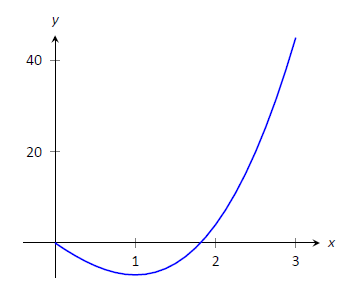
Figure : A graph of on as in Example .
Next, we find the critical values of on . ; therefore the critical values of are and . Since does not lie in the interval , we ignore it. Evaluating at the only critical number in our interval gives: .
Table gives evaluated at the "important" values in . We can easily see the maximum and minimum values of : the maximum value is and the minimum value is .
Table : Finding the extreme values of in Example
|
|
| 0 |
0 |
| 1 |
-7 |
| 3 |
45 |
Note that all this was done without the aid of a graph; this work followed an analytic algorithm and did not depend on any visualization. Figure shows and we can confirm our answer, but it is important to understand that these answers can be found without graphical assistance.
We practice again.
Example : Finding Extreme Values
Find the maximum and minimum values of on , where
Solution
Here is piecewise--defined, but we can still apply the Key Idea 2. Evaluating at the endpoints gives:
We now find the critical numbers of . We have to define in a piecewise manner; it is
Note that while is defined for all of , is not, as the derivative of does not exist when . (From the left, the derivative approaches ; from the right the derivative is 1.) Thus one critical number of is .
We now set . When , is never 0. When , is also never 0. (We may be tempted to say that when . However, this is nonsensical, for we only consider when , so we will ignore a solution that says .)
So we have three important values to consider: and . Evaluating at each gives, respectively, , and , shown in Table . Thus the absolute minimum of is 1; the absolute maximum of is . Our answer is confirmed by the graph of in Figure .
Table : Finding the extreme values of in Example
|
|
| -4 |
25 |
| 0 |
1 |
| 2 |
3 |

Figure : A graph of on as in Example .
Example : Finding Extreme Values
Find the extrema of on .
Solution
We again use Key Idea 3. Evaluating at the endpoints of the interval gives: We now find the critical values of .
Applying the Chain Rule, we find . Set and solve for to find the critical values of .
We have when and when . In general, when Thus when ( is always positive so we ignore , etc.) So when . The only values to fall in the given interval of are and , approximately .
We again construct a table of important values in Table . In this example we have 5 values to consider: .
Table : Finding the extrema of in Example
|
|
| -2 |
-0.65 |
|
-1 |
| 0 |
1 |
|
-1 |
| 2 |
-0.65 |
From the table it is clear that the maximum value of on is 1; the minimum value is . The graph in Figure confirms our results.
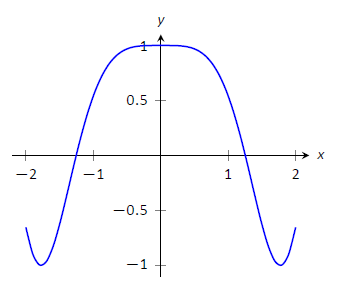
Figure : A graph of on as in Example .
We consider one more example.
Example : Finding Extreme Values
Find the extreme values of .
Solution
A closed interval is not given, so we find the extreme values of on its domain. is defined whenever ; thus the domain of is . Evaluating at either endpoint returns .
Using the Chain Rule, we find . The critical points of are found when or when is undefined. It is straightforward to find that when , and is undefined when , the endpoints of the interval. The table of important values is given in Table .
Table : Finding the extrema of the half--circle in Example
|
|
| -1 |
0 |
| 0 |
1 |
| 1 |
0 |
The maximum value is 1, and the minimum value is 0.
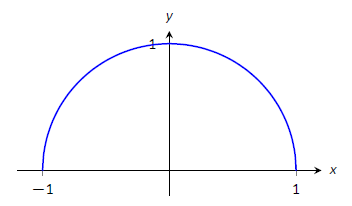
Figure : A graph of on as in Example
Note: We implicitly found the derivative of , the unit circle, in the section on Implicit Differentiation as . In Example , half of the unit circle is given as . We found . Recognize that the denominator of this fraction is ; that is, we again found
We have seen that continuous functions on closed intervals always have a maximum and minimum value, and we have also developed a technique to find these values. In the next section, we further our study of the information we can glean from "nice" functions with the Mean Value Theorem. On a closed interval, we can find the average rate of change of a function (as we did at the beginning of Chapter 2). We will see that differentiable functions always have a point at which their instantaneous rate of change is same as the average rate of change. This is surprisingly useful, as we'll see.
Contributors and Attributions
Gregory Hartman (Virginia Military Institute). Contributions were made by Troy Siemers and Dimplekumar Chalishajar of VMI and Brian Heinold of Mount Saint Mary's University. This content is copyrighted by a Creative Commons Attribution - Noncommercial (BY-NC) License. http://www.apexcalculus.com/
Integrated by Justin Marshall.













